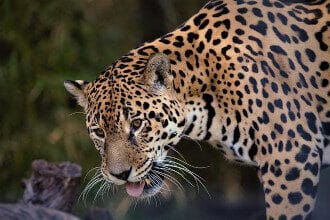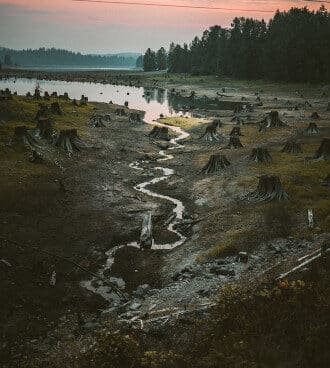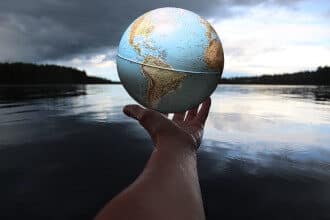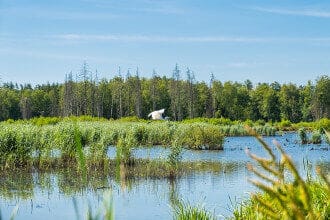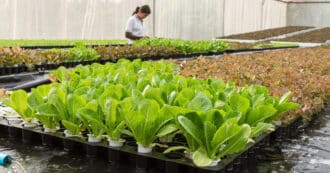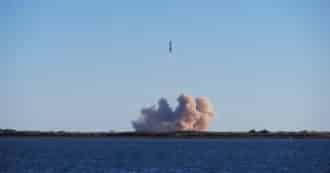By Rachel Cohen – Dr. Jared Diamond, an American geographer and author once wrote, “Elimination of lots of lousy little species regularly causes big harmful consequences for humans, just as does randomly knocking out many of the lousy little rivets holding together an airplane.” The extinction of a few species may not seem that harmful in the short run, but in the long run, it will break down the natural ecosystems, create biodiversity loss and continue to create irreversible changes we have already seen from climate change.
Previous Extinctions
Scientists refer to the current mass extinction we are seeing as the sixth mass extinction. As the name suggests, there have been five other mass extinction events.
The five other extinctions occurred over the course of hundreds of millions of years, the first being the Ordovician-Silurian extinction. This took place 440 million years ago and mainly small marine organisms died out. The next extinction was the Devonian extinction which took place 365 million years ago when tropical marine species went extinct. The third extinction took place 250 million years ago and eliminated a variety of species including many vertebrates. Further extinction took place 210 million years ago during the Triassic-Jurassic extinction. This extinction wiped out many other vertebrate species that allowed the dinosaurs to flourish. The fifth extinction was the Cretaceous-tertiary mass extinction in which ¾ of the world’s species were wiped out.
All previous extinctions were natural. However, the current sixth mass extinction is linked directly to humans.
Humans Causing The Current 6th Extinction
Humans are the reason for exacerbated global warming and climate change as well as the current mass extinction we are seeing. We are causing this extinction through our unsustainable use of nature.
Currently, 30% of land containing biodiversity has been converted for food use. This means habitats for hundred and thousands of living species have been wiped out. Clearing a forest removes homes and food sources for animals, and repeating this all over the world impacts the biodiversity and survival of many key species.
Beyond our unsustainable use of land, the dramatic use of water by humans greatly impacts the survival of animals. Water is a basic necessity of life for all living things, but the way humans use water is unsustainable and impacts the natural world.
For instance, creating just ONE cotton t-shirt requires 2,700 liters of water. Now multiplying that by the billions of T-shirts and other clothing items produced each year by the fashion industry, in addition to the water used for drinking, showering, gardening, etc. all from a finite source, does not leave much water for the animals of the world or the support of sustaining biodiversity.
We can already see the impact of our water use on bodies of water such as the Aral Sea. The irrigation of cotton in nearby countries limited the amount of water that could replenish the sea and combined with rising temperatures, the sea has disappeared reducing a water source for desert animals.
Humans and Extinction: Global Warming & Climate Change
It is a known fact that through human activities we greatly increase the Co2 in the air which traps heat on earth, leading to rising temperatures, melting glaciers, and rising sea levels. These drastic changes to the earth are greatly impacting the animals of the world.
Animals are losing habitats, and the extinction of key species is causing a chain reaction within the animal kingdom. A balance in the ecosystem keeps the biodiversity of the natural world and the disruption from humans ruins this and puts the world’s ecosystems at risk.
Categorizing Extinctions
As we talk about extinction it is important to understand the different types of “ranking” an animal or species may receive before it is labeled as an extinct species. The International Union for Conservation of Nature uses a variety of categories to classify the endangerment of animals, referred to as the Red List of Threatened Species. The seven levels include:
- least concerned
- near threatened with extinction
- vulnerable
- endangered
- critically endangered species
- extinct in the wild
- extinct
How Many Animals Go Extinct Every Day?
Now that we can understand the impact humans have on the extinction of species, let’s look deeper into how many animals and species we are losing. There are 1.7 million known species on earth but it is estimated that there are more species, as many as 8 million unknown species in existence. These species are all interconnected through the food web and have created harmony in their world, which humans have destroyed.
Before humans, there was a natural rate of extinction also known as the background rate. The background rate was the normal rate of extinction that occurred through natural causes. The earth has constantly been freezing, warming, and forming for hundreds of millions of years. Through these transitions animals and species naturally died off. Most species died from a loss of resources, natural causes, and/or the inability to reproduce for a variety of reasons. These natural changes lead to a natural rate of extinction of one species per every one million species per year. We are able to track this rate through fossil records. Sadly, this natural rate does not exist anymore as human behavior has greatly increased it.
Poaching is a human-related reason for extinction. Engaging in the illegal killing of animals, or poaching has led to a biodiversity crisis as species disappear. This biodiversity crisis is a disruption of the natural world and the balance that is set.
For example, the last White Rhino died in March 2018 after the species had been severely hunted for its ivory. Other species such as the Malaysian tiger face a similar fate.
Defining the Number of species lost each day
For all the reasons mentioned above, humans have drastically changed the world. The human impact can be seen in the extinction risk and rate of today which is estimated to be as high as 24 species a day. The issue with defining the true number is that it is hard to track as we have a massive gap between the known population and the real population of animals on earth. Thus, we may not know when an animal has died off.
Furthermore, some animals may not interact with humans on a regular basis which leads us to believe they have gone extinct. An example of this is the Guadalupe fur seal which was believed to have gone extinct over a century ago but it has now been reported that there are actually over 20,000 seals.
It is quite difficult to know exactly how many species we lose in one day, but we can deduce that through the harm humans have done to the earth, there has been just as much harm to the ecosystems, causing biodiversity loss and greatly impacting the number of species in existence today.
Take Action!
According to the Red List, “there are more than 142,500 species on The IUCN Red List, with more than 40,000 species threatened with extinction, including 41% of amphibians, 37% of sharks and rays, 34% of conifers, 33% of reef-building corals, 26% of mammals and 13% of birds.” With the threat of extinction, there is a large concern about new extinctions and what species are going extinct.
Wildlife Sanctuaries
One small step to take to try and mitigate the issue is to support organizations and conservation efforts by visiting wildlife sanctuaries. By visiting, individuals can give monetary donations which help continue the conservation efforts. Furthermore, visitors will be educated about more steps they can take to try and slow down the rate of extinction. . Learning and educating others can help individuals make more informed decisions which can create a positive impact in the long term.
Landscaping
Another step includes changing how you may take care of your landscape. It is extremely common in America to use pesticides, which may leave your grass looking beautiful but can actually be extremely harmful to the planet.
Pesticides are poisonous to animals. Any animal that may eat from your lawn or pesticide-treated plants risks the possibility of sickness or death. If a predator eats sick prey there is a risk of the predator dying as well and creating a chain reaction. Another risk with pesticides is contaminated runoff. When it rains, pesticides will runoff and contaminate water in sewers which can contaminate larger bodies of water that animals use for survival. Unknowingly, animals can be killed off and continue the threat of the sixth mass extinction.
Native Species
To further support protecting endangered species through landscaping it is important to only plant native species. Planting native species continues to support the natural wildlife through giving food options and supporting natural processes like pollination.
When non-native species are introduced it creates competition for the native plants and animals. Non-native plants can use up valuable resources killing native plants and harming the native ecosystem. The red squirrel of The United Kingdom is now a critically endangered species, found today only in The Isle Of Wight, after the grey squirrel was brought into the country from The United States.
We may not know the exact number of species that die off every day but it is more than the natural/background rate. The current sixth mass extinction has been caused by human activities including but not limited to poaching, pesticides, and invasive plants. There are small steps such as educating others, monetarily supporting conservation work, and changing some of our habits which may help reduce our losses.
Religion and Extinction
Deuteronomy 7:22 – The Lord your God will dislodge those peoples before you little by little; you will not be able to put an end to them at once, else the wild beasts would multiply to your hurt.
Protecting Species Eco Bible Volume 2
Rabbi Moshe ben Nachman (Nachmanides; Ramban) explains that if God were to let the Israelites conquer the Canaanites in one day or drive them out over a year, then the land would become desolate and overrun by wild animals. The verse is referring to the lions, leopards, and bears that once roamed biblical Israel.
In this verse, humans are being recognized as a predator species, keeping the wild animals at bay. In our times, while coronavirus lockdowns have led to some wildlife expanding their territories, even entering cities, humans still pose the greatest risk to wildlife, not the other way around. The biblical fear of large groups of wild animals is not one held by most people today.
The Australian wildfires of 2019 and 2020 pushed 100 endangered species, including Australia’s beloved koalas, closer to extinction, with an estimated one billion animals being killed by fires that bore the fingerprint of human-caused climate change. In the words of Harvard University’s Professor Richard Zeckhauser, “Humans . . . despite their regulatory tools, have contributed to innumerable extinctions. Humans can disrupt equilibrium patterns through their often outsized hunting capabilities, their habitat destruction, and their introductions of invasive species.”
One of the most recent species people made functionally extinct is the northern white rhinoceros. While our verse warns of war increasing animal populations, wars in central Africa allowed poachers to run rampant and decimate the rhino population. The last male, named Sudan, died in 2018. His caretakers “scratched Sudan’s rough skin, said goodbye, made promises, apologized for the sins of humanity,” and cried. For this subspecies, it was 55 million years of life and a farewell. The Javan, Sumatran, and black rhinos, all critically endangered, may soon suffer a similar fate.
In a limited success story, the population of Indian rhinos, the world’s largest rhinos, has risen from around 200 in 1900 to around 3,700 today. This was due to strict protection and management by wildlife authorities in India and Nepal, which moved the status of these rhinos from critically endangered to vulnerable.
Humans, unlike other predators, have a moral choice to protect species or endanger them and even drive them to extinction. The fate of millions of species is in our hands. Pulitzer Prize-winning author Elizabeth Kolbert notes that the anthropologist Richard Leakey has warned, “Homo sapiens might not only be the agent of the sixth extinction but also risks being one of its victims.”
* Featured image source


